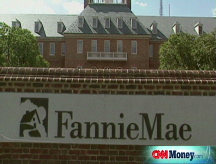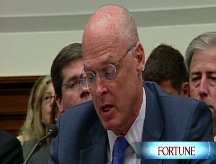Rescue cost: The big unknown
A government takeover of Fannie Mae and Freddie Mac can take many forms, and so could the cost to the U.S. Treasury.
NEW YORK (CNNMoney.com) -- If only it were the $64 million question. The taxpayer bill for rescuing Fannie Mae and Freddie Mac could turn out to be the $64 billion question. Or more - or less.
The fact is: Nobody really knows yet.
Until the housing market recovers, there's no telling how much an intervention in Fannie and Freddie could cost taxpayers. But if it costs anything, the cost will likely be in the billions, not the millions.
Just how many billions depends largely on the structure of the rescue.
The two firms, which were set up by the government to help stimulate and underpin the market for home loans, own or back $5 trillion worth of debt - half the mortgage debt in the country. Since last summer, they have suffered about $12 billion in losses.
At the same time, Fannie (FNM, Fortune 500) and Freddie (FRE, Fortune 500) have become virtually the only source of funding for banks and other lenders that offer mortgages. Their ability to buy up mortgages is crucial to the recovery of the battered home market and the broader U.S. economy.
The thinking is that Treasury Secretary Henry Paulson - sometime before Sunday evening - will put Fannie and Freddie into conservatorship. That means the government will boot management out and run the two agencies until they get back on their feet.
Such a takeover, however, does not mean that the $5 trillion of loans and loan guarantees the two agencies have on their books get put on the balance sheet of the federal government. Fannie and Freddie would continue to operate as separate entities from the government.
But should the companies' liabilities ever exceed their assets, it is likely the government would make good on its implicit guarantee to back their debt, said attorney Thomas Stanton, author of two books on Fannie and Freddie and a lecturer at Johns Hopkins University.
One reason for conservatorship, some say, is to prevent larger taxpayer losses like the kind the government saw during the savings and loans crisis in the late 1980s and early 1990s.
The move would ensure that Freddie and Fannie don't take unnecessary financial risks in an attempt to stem shareholder losses.
"When you have managers under pressure they have real incentive to bet the bank," said Stanton. "Taxpayers tend to lose a lot of money because the gambles don't pay off."
The Treasury may also opt to invest money in both companies - perhaps by every month buying bonds that it could later convert to stock. The money the Treasury invests would be taxpayer-financed.
"The only near-term cost is the amount of money the Treasury invests," said Jaret Seiberg, a financial services analyst at the Stanford Group, a policy research firm. How those investments perform will determine whether taxpayers make or lose money. And that performance is based entirely on the housing market's performance.
The fate of Fannie and Freddie is also in the hands of central bankers around the world who buy their debt. If the move to conservatorship doesn't assure them that the companies are on a sound path, the Treasury may be forced to take one or two additional steps.
Paulson could ask Congress to make the government's backing of the mortgage giants explicit by writing it into law, and he could put the companies into receivership, according to Stanton.
Under receivership, shareholders could be wiped out and the taxpayer would officially be on the hook for the agencies' bad debt. But the tab wouldn't be anything close to $5 trillion the agencies have on their books, because only a relatively small portion of the agencies' underlying home loans are likely to to default.
Of course, even a small percentage of $5 trillion is not a small amount of money.
It's impossible to put a number on it right now. But some experts say the rescue would probably cost more than the Federal Reserve's $29 billion backing of Bear Stearns assets when it was taken over by J.P. Morgan Chase.
"It will no doubt cost more than Bear - it's a lot bigger," said Lee Sheppard, a contributing editor at Tax Analysts. ![]()







